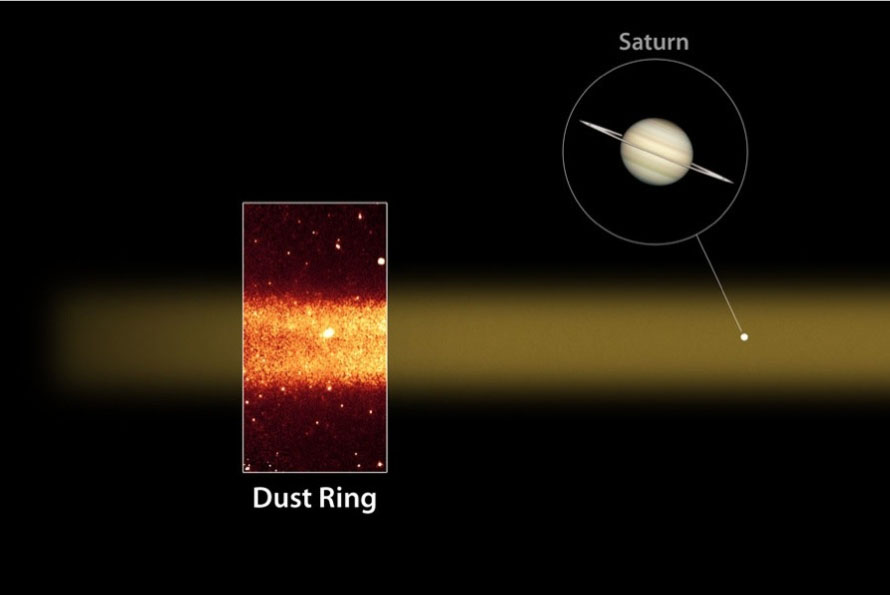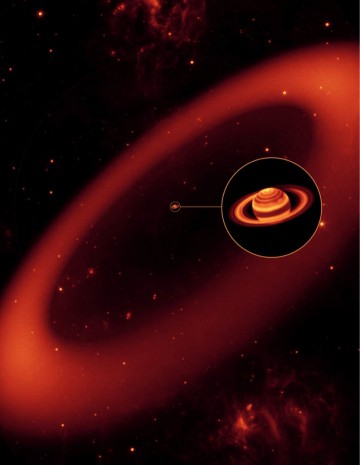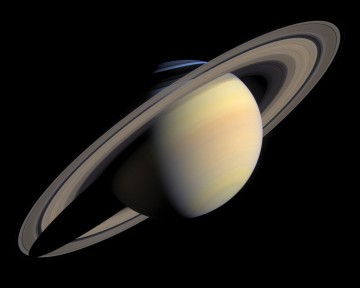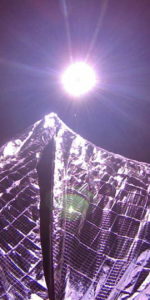
Saturn is truly the “Lord of the Rings” and one of the most majestic places in the Solar System. Its massive ring system is well-known, but in 2009 another previously unknown ring was discovered, much larger than the others but fainter, being composed of dark grains of dust thought to originate from the moon Phoebe. Now, new research indicates that the Phoebe ring is even larger than first thought.
The new findings come from NASA’s Wide-field Infrared Survey Explorer (WISE) spacecraft; the tenuous ring is now seen to extend from 3.75 million to 10.1 million miles (6 million to 16.2 million kilometers) from the planet, or about 100 to 270 times the radius of Saturn itself. Previous estimates from NASA’s Spitzer Space Telescope said the ring extended distances of 128 to 207 times the radius of Saturn, or about 4.8 million to 7.7 million miles (7.7 million to 12.4 million kilometers). Even then, that would be about 12.5 times the average distance between Earth and the Moon, more than 10 times larger than Saturn’s next largest and more visible ring, the E ring. This massive, diffuse torus-like ring dwarfs Saturn’s other rings and the planet itself.

As noted by Douglas Hamilton, a planetary scientist at the University of Maryland, College Park, in Space.com, “We knew it was the biggest ring, but know we find it’s even bigger than we thought, new and improved.”
As he told NPR, the ring is “more than 200 times as big across as Saturn itself – it’s absolutely immense, much bigger than any other ring that we know of.”
“It’s fascinating that this ring can exist,” Hamilton continued. “We’re told in science textbooks that planetary rings are small and close to their parent planets – if they’re too far away from their planets, moons form rather than rings. This discovery just turns that idea on its head – the universe is a more interesting and surprising place than we thought.”
The findings were just published in the June 11 issue of Nature.
Another moon, Iapetus, had also provided clues to the existence of the new ring.
“Like our moon, Iapetus always has one side facing toward Saturn, which means it also always has one side pointing in the direction of its motion around Saturn, its leading side,” Hamilton said. “Iapetus is an icy moon, and intrinsically bright white, but its leading face is very strikingly jet black. That contamination is what led us to look for what turned out to be a surprisingly large ring.”
The dust particles in the ring are exceedingly tiny, only about 10 to 20 microns in size. They make up the bulk of the ring, with larger particles, up to about 7.8 inches (20 centimeters) or more, making up no more than 10 percent of the ring material. The Phoebe ring is darker and less prominent due to the dust particles being darker themselves and most likely coming off the dark moon Phoebe. The particles absorb sunlight so the ring is less distinct in visible light, but more visible in infrared light. This makes it easier to see the ring in the infrared images taken by WISE. The particles are also well spread out, with most of the ring being empty space, kind of like atoms.
“A cubic kilometer of space in the Phoebe ring might have just a few dozen dust particles, maybe 100 at most,” Hamilton said. “It’s really empty.”
The ring has also been seen in optical light, however, as reported in 2014, when it was observed by the ISS camera on the Cassini spacecraft.

The particles are also thought to be millions to billions of years old, since there is little chance of any of them colliding and destroying each other sooner in collisions. The findings also show how much variety there actually is in Saturn’s rings.
As Hamilton summarized: “Saturn’s main rings are like the fabled elephant graveyard – mysterious and filled with mostly large bones that contain clues about the recent past. The E ring, then, is the chipmunk graveyard in which all of the bones are small and from the modern era, and the Phoebe ring is the dinosaur graveyard in which we find ancient bones of all sizes, most of them tiny fragments but some quite immense.”
Hamilton and his colleagues also think it is possible that Jupiter has a similar, undiscovered larger ring (besides its other already known rings which are visible but fainter than Saturn’s).
“Whenever a planet has a distant satellite, it will probably have a distant ring as well. We see Saturn’s because it’s bright enough to image; Jupiter’s is probably fainter and harder to spot.”
In related news, the Cassini spacecraft has taken beautiful new images of the moon Tethys, from a distance of approximately 118,000 miles (190,000 kilometers) and with an image scale of 3,280 feet (1 kilometer) per pixel. The largest crater, Odysseus, is 280 miles (450 kilometers) across, covering about 18 percent of the moon’s surface area; Tethys itself is only 660 miles (1,062 kilometers) across. For comparison, a similarly sized crater on Earth would be as big as Africa.
There are also some fantastic new views of Saturn’s “sponge moon” Hyperion. The unusual cratering on this small potato-shaped moon makes it look like a giant sponge, but its density is also similarly low—about half that of water—indicating the interior of the moon is quite porous. This helps to explain why Hyperion looks the way it does, since impactors would tend to compress the surface, rather than excavate it, and most of the material that is blown off the surface never returns. This is Cassini’s last close flyby of this odd moon, before the scheduled end of the mission in 2017. For its final act, Cassini will repeatedly dive through the space between Saturn and its rings before entering Saturn’s atmosphere.
Cassini’s next flyby encounter will be with the moon Dione on June 16, 2015. The spacecraft’s current position is posted and updated here.
More information on the Cassini mission is available here.
Want to keep up-to-date with all things space? Be sure to “Like” AmericaSpace on Facebook and follow us on Twitter: @AmericaSpace





One Comment
One Ping
Pingback:Saturn's massive Phoebe ring even larger than previously thought